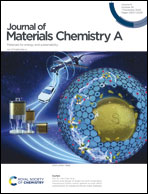A fast adaptive gating system based on the reconfigurable morphology of liquid metal via an electric field on porous surfaces†
Abstract
Gallium-based liquid metal (LM) is one of the promising materials in the design of microfluidic devices and electrical components. Although much progress has been made, it is still challenging to achieve fast morphology transformation of the LM with switchable wetting and dewetting on metal substrates. Herein, we demonstrate a strategy to achieve a switchable morphological reconfiguration of a LM droplet on a hierarchical structured porous surface, i.e., a micro/nanostructured mesh surface, via varying the electric field in alkaline solution, which can be used as a fast gate control system. When a positive voltage is applied, the LM droplet can wet and spread out on the mesh surface, accompanied by the morphology transformation from a spherical shape to a pie shape, due to surface tension reduction of the LM, while the LM droplet can quickly dewet and restore to the spherical shape with low negative voltage, owing to the cooperation of the sudden surface tension increase of the LM and low surface adhesion of the micro/nanostructured surface. Based on the switchable reconfigurable morphology of the LM droplet, the multifunctional gating system for controlling liquid permeation and light path has been verified. Therefore, this work provides a new avenue for designing a dynamic controllable gating system, which has potential applications in microfluidic systems, optical devices, microelectronic devices, etc.



 Please wait while we load your content...
Please wait while we load your content...